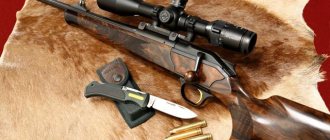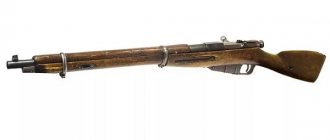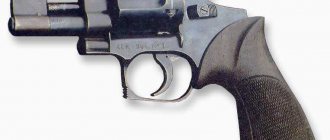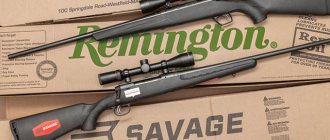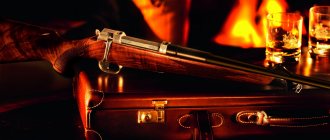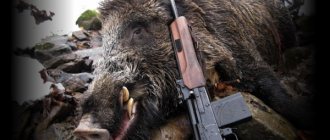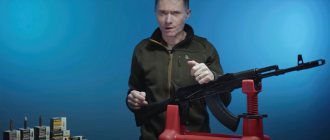USA revolver carbines: one more original than the other
Drum and drum control lever of a revolving rifle by Henry North and Chauncey Skinner
Military science at the turn of the era.
In the previous article, we began our story about revolving carbines with a story about the Colt revolving gun. And today we will continue this topic. Colt had great production capabilities, and therefore he produced them more than others.
Model 1839 carbine
Revolving rifle of Henry North and Chauncey Skinner
For example, the Model 1839 carbine, which differed from earlier models in the absence of a cocking lever and the presence of an external trigger, was manufactured in a quantity of approximately 950 carbines. And from 1839 to 1841, an additional version of it was produced - the Model 1839 shotgun chambered for a 16-gauge cartridge, produced in the amount of 225 pieces.
Although the US Navy and the State of Texas purchased several Model 1839 carbines, the weapon's high price and quality issues resulted in limited sales.
For some reason, many VO readers were especially interested in how many of these carbines Texas bought. So: on August 3, 1839, the Texas Army purchased fifty carbines for $55 each and another 30 on October 5, 1839 (at the same price and with a full set of additional accessories).
Colt 1855 with six-round magazine
"Colt" 1855 with a six-round magazine
The Model 1855 carbine had a five-shot drum with .56 caliber chambers.
An additional version was also available with a six-shot .36 or .44 caliber cylinder and matching barrel.
Between 1856-1864 A little less than 5,000 of these revolver carbines rolled off the assembly lines of the Harford plant. Almost all were sold either to the United States Army or to Civil War volunteers as sidearms.
Before the outbreak of war, several carbines were purchased for the short-lived service of the Pony Express.
Colt cavalry carbines produced during the Civil War
The following units were armed with Colt carbines: the Ohio Infantry Regiment, the 1st Colorado Cavalry, the 9th Illinois Cavalry, and the most famous of Colonel Berdan's 21st Sharpshooters.
British-made Colt carbine with 15-inch barrel
Photo of a Confederate soldier with an 1855 Colt rifle
Revolver "North and Savage No. 8"
But, as already noted, not only Colt, but also many others, were present on the revolver carbine market.
In particular, a very original model was proposed by Henry North and Chauncey Skinner, who patented it in 1852 and managed to produce about 700 of these revolving rifles by 1856. The highlight of the design was a lever (clearly visible in the photograph), turning it down pushed the cylinder forward, so that the drum chamber moved onto the barrel and closed the gap between the barrel and the drum. The same lever fixed the drum and released the trigger stopper, which created a rather complex design.
The rifles were produced by North & Savage from Middletown, Connecticut. Based on the 1856 patent, the North and Savage No. 8 revolver was made.
Apparently, the designers considered that it would be more popular on the market than a revolving gun.
Revolver "North and Savage No. 8"
James Warner Revolving Rifle
The James Warner Revolving Rifle from the Springfield Arsenal was one of the first models to compete with Colt drum guns in the US market.
It was developed in 1849–1852. It had a .40 caliber and a six-shot drum. The Model 1851 revolver rifle had a closed frame, but its drum was turned manually.
When Colt's patent was unexpectedly renewed in 1849, a frustrated Warner was forced to redesign all of his rifles to avoid prosecution.
That's why there are brass-framed Warner rifles (and even button-lock carbines) similar to the Billinghurst rifle described in the previous article.
James Warner 1851 rifle
Porter rifle
Even more unusual was the rifle of Colonel Parry W. Porter of Memphis, who invented it 1851-1853. Caliber .44. A disc-shaped drum placed on an edge with a capacity of nine charges.
Porter rifle
Apparently, Porter really wanted to circumvent Colt’s patent in any way. And he beat him!
It worked like this: when the trigger guard lever was pressed, the side hammer was cocked, and when the lever was returned, the drum was rotated and the next one was fixed in front of the barrel.
When the trigger is pulled, the side hammer hits the long hammer so that it strikes the primer, which, accordingly, ignites the charge in the drum. By the way, the central location of the drum with the frame required a sight shifted to the left.
Porter rifle mechanism
The Porter rifle went through three modifications during its short life, and each was in some way better than the previous one.
Unfortunately, all Porter rifles suffered from the same serious drawback - the drum of some of the chambers was pointed directly at the shooter’s face and hands. In the event of “chain fire” (and it was possible on this rifle due to the capsules loosely placed on the fire tubes), Porter’s rifle could fire its .44 caliber bullets in all directions. Which happened to lead to serious injuries to the shooter.
And after Samuel Colt spread the rumor that Colonel Porter had died during such an incident, his rifle was immediately stopped being purchased.
Alexander Hall rifle
Alexander Hall rifle
Hall rifle magazine
Equally original and equally impractical was the smoothbore drum gun, developed by gunsmith Alexander Hall of New York in 1855–1857.
Chambered in a relatively small .38 caliber, it was notable for its drum magazine holding as many as 15 rounds.
The shooter could unlock the drum using a lever located under the trigger guard in front of the trigger. Then I rotated it by hand to position the loaded chamber against the barrel.
The same lever activates the built-in hidden trigger, and the rear trigger is used to fire a shot. To reload the magazine, it had to be removed entirely.
The barrel was 30 inches long without rifling.
North and Skinner system
North and Savage revolving rifle, also known as the North and Skinner revolving rifle, with an under-barrel lever for tightly driving bullets into the drum
And it so happened that in 1852, Henry S. North and Chauncey D. Skinner from Middletown (Connecticut) received a patent for a revolver with forced rotation of the drum.
Unlike the Colt patent, the North and Skinner system uses a lever for this, which simultaneously functions as a trigger guard. When the shooter lowers the lever, the cylinder rotates and the hammer is simultaneously cocked.
The fun begins, however, when the lever returns to its original position. In this case, a metal wedge in the shape of a U-shaped plate enters the space behind the drum and pushes it forward towards the barrel, onto which the chamber located opposite it is put on. In this way, a “gas seal” was created, protecting the shooter from gas breakthrough and “chain fire”.
A few years later, Henry North began producing a rifle based on his patent along with Skinner.
And then, working with a Middletown gunsmith named Edward Savage, he produced about five hundred of these unusual “lever action revolvers.” In addition, the company they created, North and Savage, produced more than a hundred different versions of 0.60 caliber guns.
"North and Skinner" in the process of loading. A vertical wedge with a beveled upper part is clearly visible, pressing the drum to the barrel
The rifle was a worthy competitor to the Colt 1855 model. And she had virtually no problems with “chain fire” and cylinder rupture.
Unfortunately, its large trigger was located too high, making it difficult for the shooter to aim.
The rifle also lacks a handguard. Which made it difficult to hold in your hands.
Morris and Brown carbine
Morris and Brown carbine
In 1860–1862 Another “revolving carbine” of .44 caliber appeared in the USA. Six-shot, chambered for side-fire cartridges.
It was developed in 1860 by V.Kh. Morris and K. Brown, and was called "one of the most remarkable innovations of our time" by Scientific American magazine.
Externally, it has a very distinctive appearance and is unlike any other carbines or rifles.
It seems to be a drum carbine, but instead of a drum inside it there is a “funnel-shaped breech of the barrel”, in which there are “six branches of the barrel”. Having inserted cartridges into them and closing the bolt, the shooter cocked the internal firing pin by pulling the ring lever behind the trigger.
When fired from a gun, each bullet was directed along its own “branch” into the main barrel. Well, the powder gases were retained inside the remaining barrels of the cone. That is, the cloud of smoke when fired from this carbine was minimal.
When the ring lever is pressed again, the firing pin rotates to the next chamber. (Since the magazine itself does not rotate, it is more correct to say that the Morris & Brown is not a revolver).
Once all chambers are empty, all shell casings are pulled out of the barrels at the same time using a clever extraction mechanism.
Diagram of the Morris and Brown carbine
Only about fifty Morris and Brown carbines were produced.
The fact is that, as expected, the transition part from six barrels into one barrel quickly collapsed due to very high friction.
The history of the appearance of MC 255.
The MTs-255 revolving smoothbore hunting shotgun was developed at the Tula Arms Plant in 1993.
This is the rarest smoothbore hunting shotgun among all Soviet and Russian-made models. By the way, the Izhevsk plant does not produce such weapons. The idea of creating a smooth-bore hunting rifle based on the operating principle of a revolver is not new: there are many foreign models of this type. However, MTs-255 is the first and very successful solution of Tula gunsmiths. The production of MTs-255 continues to this day. In total, about 5 thousand copies were produced in ordinary, piece and souvenir versions. Due to its unusual nature, this smoothbore hunting shotgun is rarely found on the shelves of specialized stores and most often the MTs-255 is made to order, at least at the moment.
